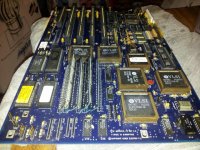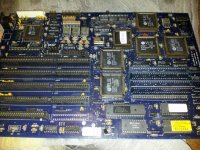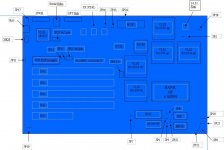rheffera
Member
I recently acquired a 286 motherboard and am having issues finding it in TH99 and google search reveals either zero or irrelevant results.
Here are names, numbers and observations:
Markings on board:
"MB286VE_12 rev 2.0
Essex Electric
Made in singapore"
Sticker on CPU & 1 sticker on the board reads EE 8192
AS the board suggests, it is a 12mhz 286.
4 x 16-bit isa slots
1 x 8 -bit slot
Pin headers for two serial connectors
AT Keyboard & standard AT power conenctor adjacent to a onboard NiCd (which i ditched as it was leaking)
VLSI Chipset(82C102A..)
4 x 30-pin simms soldered on! (3x 4256 on each)
Standard intel KB controller
pheonix Bios(?) (only phoenix chip is labelled " Compatibility Software, pheonix 1985 - 1989)
another socketed chip adjacent to the above has a label on it " EE 9002"
jp17 4-pin near battery - guessing this is ext battery.
jp21, jp 16 are only in top corner near pheonix chip. Front panel connectors?
Not alot of discrete logic. Definetley a late 286 era board.
It had some mild corrosion (but all pins appear to be intact) due to battery leakage. It had a vinegar bath and a scrub and is now air drying for a good 5 days.
Hopefully it will POST and i can get an idea of the bios
Attached below are some photos


Here are names, numbers and observations:
Markings on board:
"MB286VE_12 rev 2.0
Essex Electric
Made in singapore"
Sticker on CPU & 1 sticker on the board reads EE 8192
AS the board suggests, it is a 12mhz 286.
4 x 16-bit isa slots
1 x 8 -bit slot
Pin headers for two serial connectors
AT Keyboard & standard AT power conenctor adjacent to a onboard NiCd (which i ditched as it was leaking)
VLSI Chipset(82C102A..)
4 x 30-pin simms soldered on! (3x 4256 on each)
Standard intel KB controller
pheonix Bios(?) (only phoenix chip is labelled " Compatibility Software, pheonix 1985 - 1989)
another socketed chip adjacent to the above has a label on it " EE 9002"
jp17 4-pin near battery - guessing this is ext battery.
jp21, jp 16 are only in top corner near pheonix chip. Front panel connectors?
Not alot of discrete logic. Definetley a late 286 era board.
It had some mild corrosion (but all pins appear to be intact) due to battery leakage. It had a vinegar bath and a scrub and is now air drying for a good 5 days.
Hopefully it will POST and i can get an idea of the bios
Attached below are some photos


Last edited:

